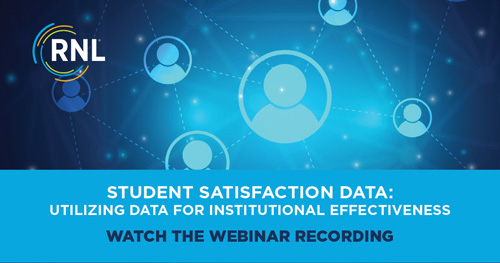student success
How to Best Use Student Satisfaction Data for Institutional Effectiveness

Last month, my colleague Shannon Cook wrote about the imperative for institutions to use student satisfaction data for institutional success. She shared that these data are critical for both the health and wealth of an institution. But as Shannon pointed out, just capturing student feedback on a regular basis will not improve student success or keep students enrolled if institutions are not in the best position to collect the data, share the results, and take action based on the perceptions of their students.
We addressed this topic during our webinar on “Student Satisfaction Data: Utilizing Data for Institutional Effectiveness.” Representatives from three institutions shared their experiences with student satisfaction assessments: the University of Cincinnati (OH), Oakland Community College (MI), and Aurora University (IL). Here are a few highlights from the wisdom and guidance they each shared.
University of Cincinnati (OH)
Julie Eagen, Director of Academic Affairs
This public institution, with more than 50,000 students on their main campus and two regional campuses, in addition to students enrolled online, has assessed student satisfaction regularly since 2010. They were able to achieve good online response rates for the Student Satisfaction Inventory (SSI) and the Priorities Survey for Online Learners (PSOL) by offering incentives such as iPads, Bearcat stickers (their mascot), and a variety of athletic wear. The student satisfaction data feeds into dashboards that they create for their leadership, allowing them to track satisfaction level shifts year over year. They create dashboards that are also unique for each of their campus locations, allowing campus leaders to identify unique experiences based on where students are taking the majority of their classes. Through this process, they learned that students had higher satisfaction at their regional locations than they did on the main campus, so that has become an area of exploration for the university. The SSI data helped them identify new housing option approaches, better understand the student experience with financial aid, and make changes in the advising system. In addition, the University has incorporated the positive areas identified on the SSI and the PSOL in their recruitment messages to attract new students in areas where they can best deliver.
“Collecting and analyzing student satisfaction data is key to understanding the state of the university. Not only do the data capture areas of concern, but the data also highlights areas to brag about to help us recruit students.”
Oakland Community College (MI)
Eleanor Fox, Research Analyst, Office of Institutional Effectiveness
The fall of 2021 was the first administration of the SSI at this multi-campus, two-year public institution in the suburbs of Detroit that serves more than 22,000 students. Their goal was to understand the student perspective at a macro level to ultimately impact retention and accreditation efforts. To achieve their good response rate, they met with the executive leadership in advance, providing talking points to various departments for assistance in promoting the survey to students. Swag and gift cards were used as incentives, with drawings done throughout the survey’s availability, and then publicized the winners in follow-up emails (“Congrats to Michele, Steve, and Kendra for winning”) so students knew that real students were receiving real gifts, and to help other students not want to miss out. As the College began to review their results, they invited RNL to meet with its executive leadership to present a high-level view of their data, before expanding by sharing the results through virtual town halls. One important note is that the Institutional Effectiveness (IE) department gave a heads-up to the departments featured in the identified challenges (areas of high importance and lower satisfaction for students), so they were aware. As a third step, IE met with various service departments to discuss the results and the opportunities for improvements. The data view of the items within the categories/scales (Academic Advising, Campus Support Services, Admissions and Financial Aid, etc.) was helpful to see student feedback in areas that were most relevant to these departments. While the initial data analysis was primarily on the big picture, with their planned fall 2023 administration, the college will drill down into the student experience at the regional campuses and track how satisfaction has improved in the past two years because of their actions.
“Results from RNL’s surveys illuminate the path to institutional excellence. With their expertise and data-driven insights, we’ve decoded students’ perspectives, charting a course for efficient and impactful change.”
Aurora University (IL)
Katie Tharp, Associate Vice President for Institutional Effectiveness and Decision Support
This private college, with locations in Illinois and Wisconsin, is a minority-serving institution with just under 6,000 students in undergraduate, graduate, and online programs. Assessing student satisfaction since at least 2014, their spring 2022 administration was a full-on effort, led by their president, to capture the feedback from as many students as possible. They established a campuswide “Your Voice Matters” campaign with class time set aside for completing the survey during an assessment week. In addition to emails from the president, outreach to students was conducted by coaches, academic advisors, and support offices. There were posters and table tents placed around campus, along with daily drawings for prizes. Program-level participation rates were monitored each day and shared to help encourage additional survey completion.
The combination of these efforts resulted in an extremely strong 40-66% response rate across the three survey instruments administered: the SSI with the undergraduate population, the Adult Student Priorities Survey (ASPS) with the graduate students, and the PSOL with the online population. (Note: average response rates are 20%). This depth of data allowed the university to break out the survey results by all programs and a variety of demographic subpopulations and to establish initiatives accordingly. As a minority-serving institution, the data for Black and Hispanic students were particularly valuable to identify differences in the student experience and to further develop a belonging initiative.
In addition to meeting with RNL to discuss their results at the executive leadership level, the University developed Action Planning and Interpretive Guides that were provided to departments. Each department met with students in focus groups and subsequently developed action plans for new initiatives to improve the student experience. The president set the tone that the data were important, and the leadership within each department followed through accordingly. In preparation for the university’s ten-year Higher Learning Commission accreditation review, they focused on advising-related items, intentionally learning more about student expectations with goal setting and experiential learning opportunities to further improve these areas. Two actions that were well received by students (resulting in standing ovations when the president announced them during student gatherings):
- The removal of large speed bumps in the parking garage; and
- The availability of both Pepsi and Coke for students in the cafeteria.
The university uncovered these simple but meaningful areas through the qualitative discussions after reviewing the quantitative data.
“RNL worked with our institution on a data collection process and timeline aligned with our needs. They provided customizable resources to facilitate communication of results, action planning, development of initiatives, and preparation for reaccreditation.”
Assessing student satisfaction on your campus
What has been your experience with assessing student satisfaction? Is it something you do regularly, or has it been a while since you gathered student feedback? Have you been able to build interest and excitement on campus for completing the survey, or are there opportunities for growth in your response rates? Once you receive the data, is it welcomed by your leadership and department heads or disregarded? Do you unpack the data with deeper dives into demographic variables and focus group conversations, or do you assume you know what students are trying to communicate? Are new initiatives for policies and procedures explored or ignored? And if actions are taken, are you adequately communicating back to students, campus personnel, and families about what has been done and why, connecting the dots between the survey responses and the improvements made, or do you expect everyone to just notice the changes for themselves?
I invite you to honestly assess your institutional effectiveness efforts and how student satisfaction surveys play a role (or not) in your actions. You may want to listen to the recording of the webinar to hear directly from these campuses on how they were able to be successful, or you may want to schedule a no-obligation conversation with my colleague Shannon Cook to discuss how you can be more effective with a fall or spring student satisfaction assessment. To attract the best students, accomplish your educational mission of graduation, and ultimately have those students become alumni who engage with the institution, you must intentionally understand what is important to your current students and how you are meeting (or not) their expectations by regularly conducting and utilizing student satisfaction assessments. RNL is here to help.
Complimentary consultation on student satisfaction assessment
Talk to our satisfaction assessment experts about how you can easily implement the survey on your campus, including when is the best time to survey and how to get strong completion rates.
